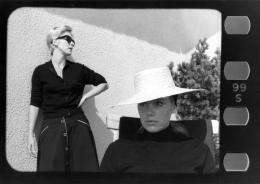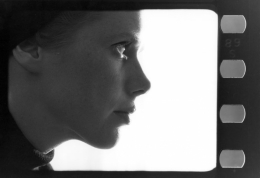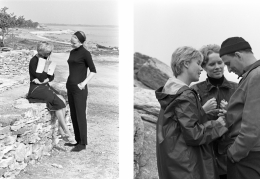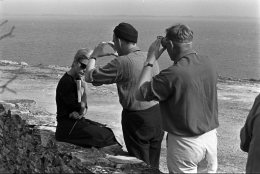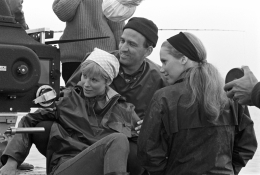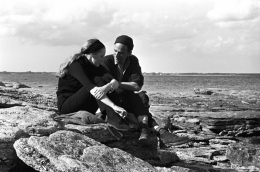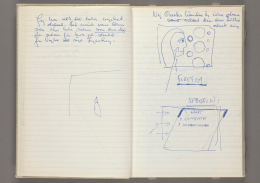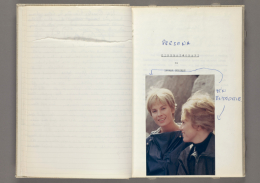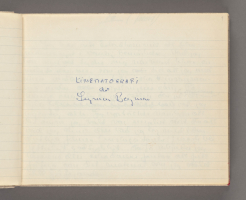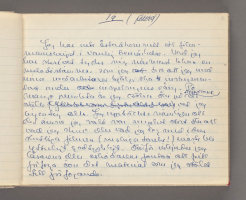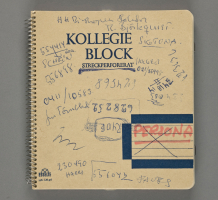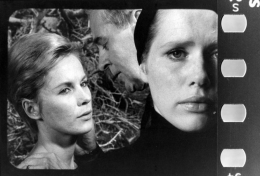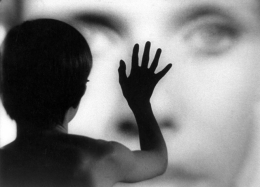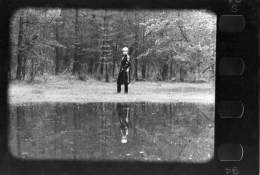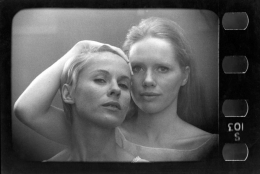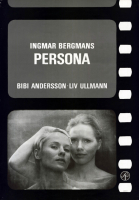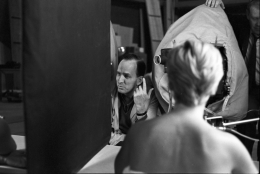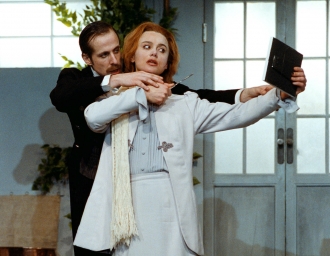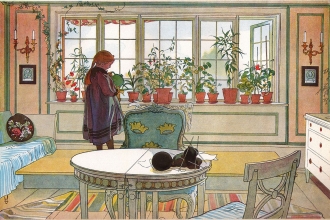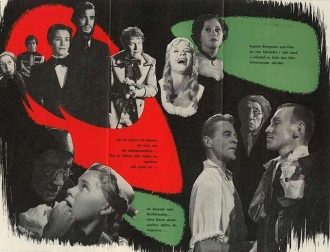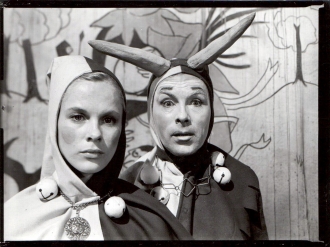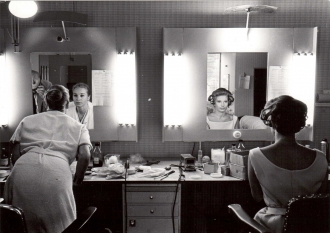Persona
As a nurse talks and her patient remains silent, their identities begin to merge.
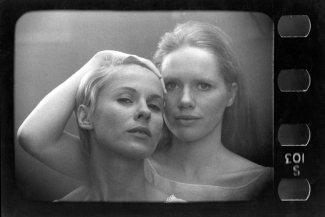
“Persona is bound to trouble, perplex and frustrate most filmgoers. Or so one would suppose.”Susan Sontag
About the film
In January 1963 Ingmar Bergman was appointed head of the Royal Dramatic Theatre. It was to prove a very demanding job indeed: with the entire company in need of reorganisation, he found himself in an 'insoluble and incomprehensibly chaotic situation.' Against his better judgement, he did not cut back on his film work and ended up paying the price: double pneumonia and acute penicillin poisoning. In the spring of 1965 he was admitted to Sophiahemmet, the royal hospital, where he began to write the screenplay for Persona, 'mainly to keep my hand in the creative process.'
In poor shape, both physical and psychological, he started to question the role of art in general, and his own work in particular.
Bergman writing in Images: My Life in Film:
'It was not a case of developing an aversion to my professional life. Although I am a neurotic person, my relation to my profession has always been astonishingly non-neurotic. I have always had the ability to attach my demons to my chariot. And they have been forced to make themselves useful. At the same time they have still managed to keep on tormenting and embarrassing my private life. The owner of the flea circus, as you might be aware, has a habit of letting his artists suck his blood.'
During the same period Bergman was awarded the Erasmus Prize (which he shared with Charlie Chaplin). Prevented by illness from attending the ceremony, he wrote an essay that was read out in Amsterdam by the head of SF, Kenne Fant. Entitled The Snakeskin, the essay summarised Bergman's broodings during his stay in hospital and his feelings about art. In many ways, Persona became an illustration of this essay (or vice-versa, perhaps), to the extent that The Snakeskin was published as the preface to the American version of the screenplay.
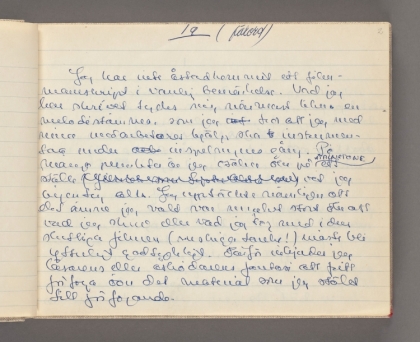
The first notes for what was to become Persona were written on 12 April 1965:
Dejection and sorrow and tears which change to powerful outburts of joy. Sensitivity in the hands. The broad forehead, severity, eyes survey the [unreadable] childishness.
What is it that I want from this, yes, to start from the beginning. Not to contrive not to incite not to cause a fuss but to start from the beginning with my new if I have one.
So she has been an actress – is that acceptable, perhaps And then she fell silent. Nothing unusual about that.
These early notes constitute a unique summary of the film. Persona has often been regarded as a watershed in Bergman's career, a new start, just as he had prescribed for himself. The subsequent writing appears to have been swift. A few pages further on in his workbook we find words that are highly relevant to the film: 'Talk to each other', 'Eroticism', 'Testimony', 'Facial studies', etc. One of the key scenes is already in place: 'What's the point of being an artist. Nurse Alma makes a passionate defence of this, but is forced to eat her words.'
At this point, there are already also some self-mocking notes in the margin of the screenplay: 'One up, one down, that's basically it.'
The two women in Persona have sometimes been regarded as one and the same person (rather like the sisters in The Silence and Cries and Whispers). This analysis does have some validity, as Bergman himself implies: 'Could one make this into an inner happening? I mean, suggest, that it is a composition for different voices in the same soul's concerto grosso?'
Bergman has often made use of musical metaphors when describing Persona. At a later date he would referred to it as a sonata for the instruments Andersson and Ullmann. Asked whether the sonata should be in a major or minor key, he replied that it should be neither, 'the way it is in modern music.'
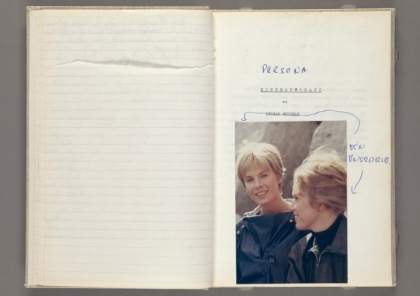
Keeping his hand in the creative process' started to pay off, and it became clear that a film might be forthcoming, after all. Having thought about casting, Bergman decided that the principal roles should go to Bibi Andersson and the highly-praised young Norwegian actress, Liv Ullmann. He had never actually seen her act, but he had been at the home of Gunnel Lindblom looking at slides taken during the shooting of Pan, in which Andersson and Ullmann both took part. Struck by how similar they were, this initial impulse eventually led Bergman to Persona.
Later he would be asked how he could be so sure that Liv Ullmann would cope with such a demanding role when he had only met her once, and then on the street: 'I wasn't. I just thought so.' He received a visit in hospital from Kenne Fant, and together they left Sophiahemmet on a visit to the Thielska Gallery on Stockholm's Djurgården. 'Now listen, Kenne, do you think you could put some people aside for me until the end of July. And we could sign up Liv Ullmann and Bibi Andersson, and you could put up the money and maybe debet what it costs to my next film, if there is one?'
Reasonably enough, Kenne Fant wondered what the film would be about, to which Bergman replied: 'Well, it's about one person who talks and one who doesn't, and they compare hands and get all mingled up in one another.' 'Oh, really,' said Kenne. I said: 'It'll be a very small film, so it needn't cost much.' Kenne put up the money wholeheartedly. And that's something I'll never forget.'
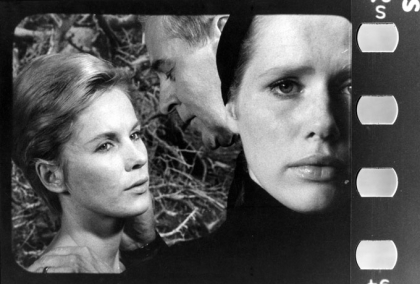
Fant's willingness to finance such a risky project should, however, be seen in the context of The Silence, which two years earlier had been SF's greatest ever box office success. This may go some way towards explaining his ready generosity.
The finished screenplay is not dissimilar to the random jottings in Bergman's workbook, yet although it may appear somewhat improvised, it was 'painstakingly planned.' Nonetheless, it is prefaced by the reservation that much of the film will be determined once shooting is underway.
Sources of inspiration
Of the much fêted opening scenes in the film, Bergman has said that he wanted to make a poem in images. Writing in Images:
'I reflected on what was important, and began with the projector and my desire to set it in motion. But when the projector was running, nothing came out of it but old ideas, the spider, God's lamb, all that dull stuff. My life then consisted of dead people, brick walls, and a few dismal trees out in the park.'
The first of these images came to him early on in the creative process. In his workbook he wrote that he imagined a white, washed-out strip of film: 'It runs through the projector and gradually there are words on the sound tape (which perhaps runs beside the film strip itself). Gradually the precise word I'm looking for comes into focus. Then a face you can barely make out dissolves in all that whiteness. That's Alma's face. Mrs. Vogler's face.'
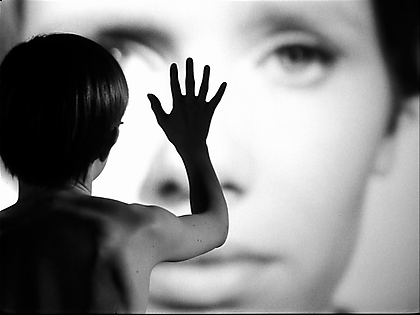
The words in this early draft are basically the same as those of the finished screenplay: 'I imagine the transparent ribbon of film rushing through the projector. Washed clean of signs and pictures, it produces a flickering reflected light from the screen.'
Bergman has often, especially during the 1960s and 70s, been accused of being unworldly. In Sweden in particular, his unwillingness to get involved in the debate surrounding the Vietnam War was widely regarded as a kind of implicit support for the USA. Persona, however, gives the first glimpse of a political reality outside Bergman's own universe. The film contains two images which invoke a strong reaction in Elisabet Vogler: a Second World War photograph of a young boy in the Warsaw Ghetto, and television pictures of one of the Vietnamese monks who set fire to themselves in protest against the war. In his workbook Bergman wrote:
'My art cannot melt, transform, or forget: the boy in the photo with his hands in the air or the man who set himself on fire to bear witness to his faith. I am unable to grasp the large catastrophes. They leave my heart untouched. At most I can read about such atrocitites with a kind of greed a pornography of horror. But I shall never rid myself of those images. Images that turn my art into a bag of tricks, into something indifferent, meaningless.'
Many have seen August Strindberg's one-act play The Stronger, in which one character speaks and another remains silent, as an important source of inspiration. Yet once again, as with Wild Strawberries almost a decade previously, the influence of same writer's A Dream Play can clearly be discerned. (Bergman produced the play for television in 1963 and later for the stage in 1970, 1977 and 1986). The free structure of Strindberg's play, in which 'time and space do not exist', has often been cited as a precursor of the dream-like form of Persona.
Shooting the film
A few days before shooting began a press conference was held with all the pomp and circumstance which was 'only normally reserved for royalty or heads of state', according to one reporter.
Having assured himself that everyone could hear properly, Bergman went up to a blackboard and wrote: PERSONA. 'Does anyone know what this is?' No answer was forthcoming from the press. 'You see', Bergman went on, 'the film might not have a name at all. First of all I suggested to Kenne Fant (at SF) the title Cinematography?' but that made Kenne sad. 'Terrible name', thought Kenne. So I came up with this title, 'Persona'. 'Any name's better than cinematography', said Kenne, and approved my proposal. Bergman then went on to explain that 'Persona' is the Latin name for the face masks worn by actors in antiquity. 'It's an amusing title, a good name, an apt name. The film will be about people's masks and attitudes.' Bergman also mentioned that the film would be shot in standard format in black and white, 'which I think is the most beautiful.'
Most of the shooting took place on Fårö but began with some work in the studio, Filmstaden, starting on 19 July 1965. 'The first days were nightmarish. All I felt was: 'I can't manage this!' and one day after another went by, and all the time we got only bad results, bloody awful results. And Bibi was angry and Liv was nervous, and I was paralyzed with fatigue.' When they arrived at Fårö, the atmosphere was much improved and work proceeded more smoothly.
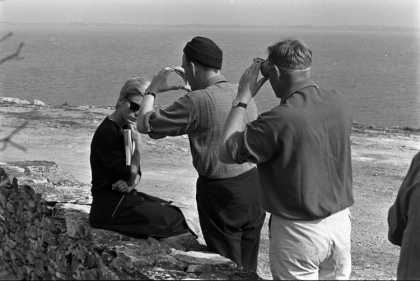
Sven Nykvist was faced with new challenges. The close-up in the opening sequences of an old film projector with carbon rods that meet together was not an easy shot to achieve. While Nykvist was shooting Mai Zetterling's Loving Couples he worked on this sequence in his spare time: 'the studio manager was annoyed because I was using up so much raw film outside the regular budget even before shooting had begun.'
Working together on The Virgin Spring Nykvist and Bergman had arrived at the conclusion that medium shots were 'boring and unnecessary', but few films are so pictorially radical as Persona: a few wide-angle long shots, hardly any medium shots and most of all long, intensive close-ups. It was probably Persona that firmly established the 'Nykvist style', summed up rather facetiously as 'two faces and a teacup'.
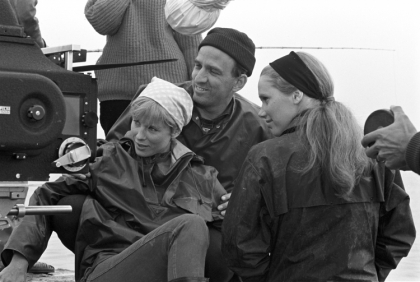
Bibi Andersson had acted in most of Bergman's films since Smiles of a Summer Night, with the notable exception of the 'trilogy' (Through a Glass Darkly, Winter Light and The Silence). The roles she had played were important yet relatively minor. Persona was to be her tour de force. On one occasion Bergman said of Andersson that she needed to believe in something before she could act it. This might sound like a limitation, yet in Bergman's eyes it was a sign of integrity. One example of this in Persona is Alma's famous monologue about a sexual adventure she once had on a beach with another woman and two young boys. During the shooting Bergman wanted to scrap the scene, perhaps because he thought it was too explicit. But Andersson insisted that they keep it in. Remenicing in an interview in American Film:
'I said, 'Let me shoot it, but let me just alter certain words no woman would ay. It's written by a man, and I can feel it's a man. Let me change certain things.' He said, 'You do what you want with it. We'll shoot it, and then we'll go and see it together.''
Shooting the scene was embarrassing, yet Bergman was pleased with the result. There was just one thing, though: 'something's wrong with the sound', he claimed. He asked Andersson to speak the monologue again alone in the mixing studio. The sound would be synchronised afterwards. The sound problem was probably just a ruse: originally she had spoken in a high, girlish voice and been satisfied with that, but when she subsequently dubbed the scene alone she used a much lower tone, something she only dared to do when nobody was watching or listening. Later she expressed the view that the intimate quality of the scene was largely down to this re-take.
For Liv Ullmann, a few years younger than Andersson, this was her first Bergman film. Many more were to follow: she played leading roles in nine films up to and including Autumn Sonata. The largely silent role of Elisabet also marked the start of a highly successful international career.
The most famous image from the film is that of an extraordinary face, half Ullmann's and half Andersson's. According to Bergman, 'In most people one side of the face is more attractive than the other, their so-called good side.' The two images that Nykvist spliced together 'showed their respective bad sides.' When the film came back from the laboratory he asked both the actresses to come to the editing room. 'Bibi exclaims in surprise: 'But Liv, you look so strange!' And Liv says: 'No, it's you Bibi, you look very strange!'
The film's unit manager, and the photographer of a number of remarkable stills from the shoot, was Bo Arne Vibenius. Some years later he directed a film that was banned in Sweden: Thriller: a Cruel Picture, recently revealed as an important source of inspiration for Quentin Tarantino's Kill Bill.
The original score was by the composer Lars Johan Werle, best known for his operas including Dreaming About Thérèse (Drömmen om Thérèse, 1964) and The Journey (Resan, 1970). His previous film scores included the music for Alf Sjöberg's The Island. He had also composed the music for Sjöberg's Royal Dramatic Theatre production of Euripides' Hippolytus, where he first met Bergman, then head of the theatre. Bergman's brief was precise: he knew exactly what he wanted. These limitations on his artistic freedom did not trouble Werle, who was extremely positive about working with Bergman and did not feel unduly restricted by his demands.
Epilogue
Shooting came to an end on 15 September 1965. The next day, Bergman wrote in his diary that now the filming was over, Bibi was off to America, Sven to Zurich and Liv to Oslo, he was left alone, depressed and self-pitying. 'On Monday the endless saga at the Royal Dramatic Theatre begins again. How will I put up with it?' A few months later he resigned his post as head of the theatre.
Persona was premièred at the Spegeln cinema on 18 October 1966. The editor Ulla Ryghe has described how the famous scene where the film burns up, often interpreted as if the actual celluloid cannot stand the friction between the two main characters, caused a number of problems at the initial screenings. After a number of projectionists had stopped the film, the film cans themselves had to be marked with red labels assuring them that the actual film does not catch fire, even though it appears that way.
The Stockholm press was largely respectful and appreciative, yet almost unanimously perplexed by a film, the content of which, symbolic or otherwise, was shrouded in mystery. Dagens Nyheter's Mauritz Edström wrote a long review (most of the reviews were unusually long) under the heading 'Bergman's victory over silence' (most probably a reference to the earlier film The Silence, at the same time as conveying a view that many critics have subsequently repeated):
'Ingmar Bergman's new film 'Persona', as I see it, is a reminder of our proximity to the ultimate borderline, where language breaks down, images are rent asunder and reality dissolves. It touches me as a personal confession, a howl of despair or a cry against darkness and silence [...] A defiant cry, an attempt to ward off the threat that lies in this despair.'
Edström's words bear an uncanny similarity to those of the director himself. He could hardly have known that on 24 July – just before he started to write Persona – Bergman had written in his workbook almost exactly the same thing: 'Even if prayer is just a cry into an empty space, we should not desist from that cry.'
The editor of Dagens Nyheter, Olof Lagercrantz, who both panned Bergman (his review of Smiles of a Summer Night is legendary), and praised him in equal measure, wrote a cutting yet amusing reflection in response to the film under the heading "Person(a)cult": 'The halo has been pressed down to the level of the sweat band of the world famous director's beret. The head of SF, Kenne Fant, can once again proclaim with a tremor of idealism in his voice that it it is a great honour to lose money on a film like 'Persona'. He said the same thing about the box-office hit 'The Silence'.'
France was the country where Bergman reaped his first major successes at the end of the 1950s. Yet during the 60s his star had been on the wane. Persona helped to restore his reputation: Les cahiers du cinéma called Persona his most beautiful film, and one daily newspaper declared that sixty years after its birth, the cinema had now found its most promising form. Reactions in America were mixed: Susan Sontag's famous essay in the magazine (albeit British) Sight & Sound is an example of praise, whereas the short notice in Films in Review is the opposite: 'a film about lesbians and lesbianism'.
Bergman insisted that all marketing material for the film, including stills, should feature the perforated edge of the film strip in order to emphasise the markedly filmic quality of the work.
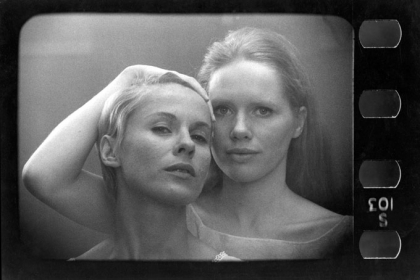
If Wild Strawberries is Bergman's most plagiarised film, and The Seventh Seal his most parodied, then Persona is certainly the most written about. No other individual Bergman film has generated such extensive critical and academic attention. One of the latest works on the subject is an anthology in the Cambridge Film Handbooks series edited by Lloyd Michaels, entitled simply Ingmar Bergman's Persona. Widely regarded as his most important film, this view of Persona is shared by Bergman himself. Writing in Images:
At some time or other, I said that Persona saved my life – that is no exaggeration. If I had not found the strength to make the film, I would probably have been all washed up. One significant point: for the first time I did not care in the least whether the result would be a commercial success. The gospel according to which one must be comprehensible at all costs, one that had been dinned to me ever since I worked as the lowliest manuscripts slave at Svensk Filmindustri, could finally go to hell (which is where it belongs!)
Today, I feel that in Persona – and later in Cries and Whispers – I had gone as far as I could go. And that in these two instance, when working in total freedom, I touched wordless secrets that only the cinema can discover.
Sources
- The Ingmar Bergman Archives.
- Ingmar Bergman, Images: My Life in Film.
- "Dialogue on Film: Bibi Andersson.", American Film, March 1977.
- Maaret Koskinen, Spel och speglingar: en studie i Ingmar Bergmans filmiska estetik, (Stockholm: Univ., cop. 1993).
- Ingmar Bergman's Persona, red. Lloyd Michaels, (Cambridge/New York: Cambridge University Press, 2000).
- Olof Lagercrantz, "Person(a)kult", Dagens Nyheter, 23 October 1966.
- "Möte med mästaren", Stockholms-Tidningen, 16 July 1965.
- "Werle-musik i 'Persona': Anvisningar hämmar ej'", Svenska Dagbladet, 21 October 1965.
- Susan Sontag, "Persona", Sight and Sound, Autumn 1967.
"Persona" by Susan Sontag, Sight and Sound, Autumn 1967:
One impulse is to take Bergman's masterpiece for granted. Since 1960 at least, with the breakthrough into new narrative forms propagated with most notoriety (if not greatest distinction) by Last Year in Marienbad, audiences have continued to be educated by even more elliptical and complex work. As Resnais' imagination was subsequently to surpass itself in Muriel, a succession of ever more difficult and rewarding films has turned up in recent years. But that good fortune releases nobody who cares about films from acclaiming work as original and triumphant as Persona. It is depressing that the film has thus far received only a fraction of the attention it deserves - at least in New York and Paris. (At the moment of writing, it hasn't yet opened in London.)
Of course, some of the paltriness of the critics' reaction may be more a response to the signature Persona carries than to the film itself. That signature has come to mean a prodigal tirelessly productive career; a rather facile, often merely beautiful, by now (it seemed) almost over-size body of work; a lavishly inventive, sensual, yet somewhat melodramatic talent, employed with what appeared to be a certain complacency, and prone to embarrassing displays of intellectual bad taste. From the Fellini of the North, exacting filmgoers could hardly be blamed for not expecting, ever, a truly great film. But Persona happily forces one to put aside such dismissive preconceptions about its author.
The rest of the neglect of Persona may be set down to emotional squeamishness; the film, like much of Bergman's recent work, bears an almost defiling charge of personal agony. I'm thinking particularly of The Silence – most accomplished, by far, of the films made before this one. And Persona draws heavily on the themes and schematic cast established in The Silence. (The principal characters in both films are two women bound together in a passionate agonised relationship, one of them the mother of a drastically neglected small boy. Both films take up the themes of the scandal of the erotic, the polarities of violence and powerlessness, reason and unreason, language and silence, the intelligible and the unintelligible.) But the new film ventures at least as much beyond The Silence as the distance separating that film, by its emotional power and subtlety, from Bergman's entire previous work.
That distance gives, for the present moment, the measure of a work which is undeniably 'difficult'. Persona is bound to trouble, perplex and frustrate most filmgoers – at least as much as Marienbad did in its day. Or so one would suppose. But, heaping imperturbability upon relative neglect, critical reaction has shied away from associating anything very baffling with the film. The critics have allowed, mildly, that the latest Bergman is unnecessarily obscure. Some add that this time he's overdone the mood of unremitting bleakness. It's intimated that with this film he has ventured out of his depth, exchanging art for artiness. But the difficulties and rewards of Persona are much more formidable than such banal objections would suggest.
Of course, evidence of these difficulties is available anyway. Why else all the discrepancies plain misrepresentations in critics' accounts of what actually happens during the film? Like Marienbad, Persona seems to be full of obscurity. Its general look has nothing of the built-in, abstract evocativeness of the chateau in Resnais' film: the space and furnishings of Persona are anti-romantic, cool, clinical, and bourgeois modern. But there's no less of a mystery lodged in this setting. Images and dialogue are given which the viewer cannot help but find puzzling, not being able to decipher whether certain scenes take place in the past, present or future; and whether certain images and episodes belong to 'reality' or 'fantasy'.
One common approach to a film presenting difficulties of this now fairly familiar sort is to declare such distinctions to be irrelevant, and the film to be actually all of one piece. What's happened is that its action has been situated in a merely (or wholly) 'mental' universe. But this approach merely postpones the difficulty, it seems to me. Within the structure of what is shown, the elements continue being related to each other in the ways that might have led the viewer to settle for supposing some events to be 'real' and' others visionary (whether dream, fantasy, hallucination or extra-worldly visitation). For example: causal connections observed in one portion of the film are flouted in another part; several equally persuasive but mutually exclusive explanations are given of the same event. These discordant internal relations are only transposed, intact, when the whole film is relocated in the mind.
Actually, it's no more helpful to describe Persona as a wholly subjective film, one taking place entirely within someone's head, than it was (how easy to see that now) in elucidating Marienbad, a film whose disregard for conventional chronology and a clearly delineated border between fantasy and reality could scarcely have constituted more of a provocation than Persona.
What first needs to be made clear about Persona is what can't be done with it. The most skilful attempt to arrange a single, plausible anecdote out of the film must leave out or contradict some of its key sections, images and procedures. It's the failure to perceive this critical rule that has led to the flat, impoverished and partly inaccurate account of the film promulgated almost unanimously by reviewers.
According to this account, Persona tells the story of two women. One is a successful actress, evidently in her mid-thirties, named Elizabeth Vogler (Liv Ullmann), now suffering from an enigmatic mental collapse whose chief symptoms are muteness and a near-catatonic lassitude. The other is the pretty young nurse of twenty-five named Alma (Bibi Andersson) charged with caring for Elizabeth – first at the mental hospital, then at the beach cottage loaned to them by the woman psychiatrist who is Elizabeth's doctor and Alma's supervisor. What happens in the course of the film, according to the critics' consensus, is that, through some mysterious process, each of the two women becomes the other. The officially stronger one, Alma, gradually assumes the problems and confusions of her patient, while the sick woman, felled by despair and/or psychosis, regains her power of speech and returns to her former life. (The viewer doesn't see this exchange consummated: what he sees at the end of Persona looks like an agonised stalemate. But it was widely reported that the film, until shortly before it was released, contained a brief closing scene which showed Elizabeth on the stage again, apparently completely recovered. From this, presumably, the viewer was to infer that the nurse is now mute and has taken on the burden of her despair.)
Proceeding from this constructed version, half 'story' and half 'meaning', critics have read off a number of further meanings. Some regard the transaction between Elizabeth and Alma as illustrating some impersonal law which operates intermittently in human affairs, no ultimate responsibility pertains to either of them. Others posit a conscious cannibalism of the innocent Alma by the actress – and thus read the film as a parable of the predatory energies of the artist, forever scavenging life for 'material'. Other critics move quickly to an even more general plane, and extract from Persona a diagnosis of the contemporary dissociation of personality, a demonstration of the inevitable failure of good will and trust and predictably correct views on such matters as the alienated affluent society, the nature of madness, psychiatry and its limitations, the American war in Vietnam, the Western legacy of sexual guilt, and the Six Million. (Then they often go on, as Michel Cournot did in Le Nouvel Observateur, to chide Bergman for this vulgar didacticism which they have imputed to him.)
My own view is that, even when turned into a 'story', this prevailing account of Persona grossly oversimplifies and misrepresents. True, Alma does seem to grow progressively more vulnerable; in the course of the film she is reduced to fits of hysteria, cruelty, childish dependence and (probably) delusion. It's also true that Elizabeth gradually becomes stronger, that is, more active, more responsive; though her change is far subtler and, until virtually the end, she still refuses to speak. But all this is hardly tantamount to an 'exchange' of attributes and identities. Nor is it established that Alma, however much she does come, with pain and longing, to identify herself with the actress, takes on Elizabeth's dilemmas, whatever these may be. (They're far from made clear.)
With Persona, it's the temptation to invent more 'story' that has to be resisted. Take, for instance, the scene which starts with the abrupt presence of a middle-aged man wearing dark glasses (Gunner Björnstrand) near the beach cottage. All we see is that he approaches Alma, addressing her and continuing to call her, despite her protests, by the name of Elizabeth, that he tries to embrace her; that throughout this scene Elizabeth's impassive face is never more than a few inches away; that Alma suddenly yields to his embraces, saying "Yes, I am Elizabeth" (Elizabeth is still watching intently), and goes to bed with him amid a torrent of endearments. Then we see the two women together (shortly after?); they are alone, behaving as if nothing has happened.
This sequence can be taken as illustrating Alma's growing identification with Elizabeth, and gauging the extent of the process by which she is learning (really? in her imagination?) to become Elizabeth. While Elizabeth has voluntarily (?) renounced being an actress, by becoming mute, Alma is involuntarily and painfully engaged in becoming that Elizabeth Vogler, the performer, who no longer exists. Still, nothing we see justifies describing this scene as most critics have done as a 'real' event – something that happens in the course of the plot on the same level as the initial removal of the two women to the cottage. But neither can we be absolutely sure that this, or something like it, isn't taking place. After all, we do see it happening. (And it's in the nature of cinema to confer on all events, without indications to the contrary, an equivalent degree of reality: everything shown on the screen is 'there', present.)
The difficulty is that Bergman withholds the kind of clear signals for sorting out what's fantasy from what is 'real' offered, for example, by Buñuel in Belle de Jour. Buñuel has put the clues there, he wants the viewer to be able to decipher his film. The insufficiency of the clues Bergman has planted must be taken to indicate that he intends the film to remain partly encoded. The viewer can only move towards, but never achieve, certainty about the action. However, so far as the distinction between fantasy and reality has any use in understanding Persona, I should argue that much more than critics have allowed of what happens in and around the beach cottage is most plausibly understood as Alma's fantasy. One prime piece of evidence is a sequence occurring soon after the two women arrive at the seaside. It's the sequence in which, after we have seen (i.e., the camera has shown) Elizabeth enter Alma's room and stand beside her and stroke her hair, we see Alma, pale, troubled, asking Elizabeth the next morning "Did you come to my room last night?" And Elizabeth, slightly quizzical, anxious, shaking her head No.
Now, there seems no reason to doubt Elizabeth's answer. The viewer isn't given any evidence of a malevolent plan on her part to undermine Alma's confidence in her own sanity nor for doubting Elizabeth's memory or sanity in the ordinary sense. But if that is so, two important points may be taken as established early in the film. One is that Alma is hallucinating – and, presumably, will continue doing so. The other is that hallucinations or visions will appear on the screen with the same rhythms, the same look of objective reality, as something 'real'. (However, some clues, too complex to describe here are given in the lighting of certain scenes.) And once these points are granted, it seems highly plausible to take at least the scene with Elizabeth's husband as Alma's fantasy, as well as several scenes in which there is a charged, trance-like physical contact between the two women.
But even to make any headway sorting out what Alma imagines from what may be taken as really happening is a minor achievement. And it quickly becomes a misleading one, unless subsumed under the larger issue of the form of exposition employed by the film. As I have suggested, Persona is constructed according to a form that resists being reduced to a 'story' – say, the story about the relation (however ambiguous and abstract) between two women named Elizabeth and Alma, a patient and a nurse, a star and an ingenue, alma (soul) and persona (mask). The reason is that reduction to a 'story' means, in the end, a reduction of Bergman's film to the single dimension of psychology. Not that the psychological dimension isn't there. It is. But a correct understanding of Persona must go beyond the psychological point of view.
This seems clear from the fact that Bergman allows the audience to interpret Elizabeth's mute condition in several ways – as involuntary mental breakdown, and as voluntary moral decision leading either towards self-purification or suicide. But whatever the background of her condition, it is much more in the sheer fact of it than in its causes that Bergman wishes to involve the viewer. In Persona, muteness is first of all a fact with a certain psychic and moral weight, a fact which initiates its own kind of causality upon en 'other'.
I am inclined to impute a privileged status to the speech the psychiatrist makes to Elizabeth, before she departs with Alma to the cottage. The psychiatrist tells the silent, stony-faced Elizabeth that she has understood her case. She has grasped that Elizabeth wants to be sincere, not to play a role; to make the inner and the outer come together. And that having rejected suicide as a solution, she has decided to be mute. She advises Elizabeth to bide her time, to live her experience through; and at the end of that time, she predicts, the actress will return to the world... But even if one treats this speech as setting forth a privileged view, it would be a mistake to assume that it's the key to Persona; or even to assume that the psychiatrist's thesis wholly explains Elizabeth's condition. (the doctor could be wrong, or at least be simplifying the matter.) By placing this speech early in the film, and by never referring explicitly to this 'explanation' again, Bergman has, in effect, both taken account of psychology and dispensed with it. Without indicating that he regards psychological explanation as unimportant, he clearly consigns to a relatively minor place any consideration of the role the actress's motives have in the action.
In a sense, Persona takes a position beyond psychology. As it does, in an analogous sense, beyond eroticism. The materials of an erotic subject are certainly present, such as the 'visit' of Elizabeth's husband. There is, above all, the connection between the two women themselves which, in its feverish proximity, its caresses, its sheer passionateness (avowed by Alma in word, gesture and fantasy) could hardly fail, it would seem, to suggest a powerful, if largely inhibited, sexual involvement. But in fact, what might be sexual in feeling is largely transposed into something beyond sexuality, beyond eroticism even. The only purely sexual episode is the scene in – which Alma, sitting across the room from Elizabeth, tells the story of the beach orgy. Alma speaks, transfixed, reliving the memory and at the same time consciously delivering up this shameful secret to Elizabeth as her greatest gift of love.
Entirely through discourse, without any recourse to images (through a flashback), a violent sexual atmosphere is generated. But this sexuality has nothing to do with the 'present' of the film, and the relationship between the two women.
In this respect, Persona makes a remarkable modification of the structure of The Silence, where the love-hate relationship between the sisters had an unmistakable sexual energy. In Persona, Bergman has achieved a more interesting situation by delicately excising or transcending the possible sexual implications of the tie between the two women. It is a remarkable feat of moral and psychological poise. While maintaining the indeterminacy of the situation Bergman can't give the impression of evading the issue, and he mustn't present anything that is psychologically improbable.
The advantages of keeping the psychological aspects indeterminate (while internally credible) are that Bergman can do many other things besides tell a 'story'. Instead of having a full-blown 'story' on his hands, he has something that is in one sense cruder, and in another more abstract: a body of material, a subject. The function of the 'subject' or 'material' may be as much its opacity, its multiplicity, as the manner in which it yields itself up to being incarnated in a determinate plot. One predictable result of a work constituted along these principles is that the action would appear intermittent, porous shot through with intimations of absence, of what could not be univocally said.
This procedure doesn't mean that a narration of this type has forfeited 'sense'. But it does mean that 'sense' isn't necessarily tied to a determinate plot. What is envisaged instead is the possibility of an extended narration composed of events which are not (wholly) explicated, but which are nevertheless possible. The 'forward' movement of such a narrative might be measured by reciprocal relations between its parts e.g. displacements – rather than by ordinary realistic (mainly psychological) causality. Often there might exist what could be called a dormant plot. Still, critics have better things to do than ferreting out the story line as if the author had – through mere clumsiness or error or frivolity or lack of craft concealed it. In such narratives, it isn't a question of a plot that has been mislaid but of one that has been (at least in part) annulled. That intention, whether conscious on the artist's part or merely implicit in the work, should be taken at face value and respected.
Take the matter of information. One tactic upheld by traditional narrative is to give 'full' information, so that the ending of the viewing or reading experience coincides, ideally. with full satisfaction of one's desire to 'know', to understand what happened and why. (This is, of course, a highly manipulated quest for knowledge. It's the business of the artist to convince his audience that what they haven't learned at the end they can't know, or shouldn't care about knowing.) But one of the salient features of new narratives is a deliberate, calculated frustration of the desire to 'know'. Did anything happen last year at Marienbad? What did become of the girl in L'Avventura? Where is Alma going when she boards a bus alone in one of the final shots of Persona?
Once it is conceived that the desire to 'know' may be (in part) systematically thwarted, the old expectations about plotting can no longer hold. At first, it may seem that a plot in the old sense is still there; only it's being related at an oblique, uncomfortable angle, where vision is obscured. Eventually though it needs to be seen that the plot isn't there at all in the old sense, and therefore that the point isn't to tantalise but to involve the audience more directly in other matters, for instance in the very processes of 'knowing' and 'seeing'. (A great precursor of this conception of narration is Flaubert. And the method can be seen in Madame Bovary, in the persistent use of the off-centre detail in description.)
The result of the new narration, then, is a tendency to de-dramatise. In, for example, Journey to Italy or L'Avventura we are told what is ostensibly a story. But it is a story which proceeds by omissions. The audience is being haunted, as it were, by the sense of a lost or absent meaning to which even the artist himself has no access.
The avowal of agnosticism on the artist's part may look like unseriousness or contempt for the audience. But when the artist declares that he doesn't 'know' any more than the audience knows, what he is saying is that all the meaning resides in the work itself. There is no surplus, nothing 'behind' it. Such works seem to lack sense or meaning only to the extent that entrenched critical attitudes have established as a dictum for the narrative arts that meaning resides solely in this surplus of 'reference' outside the work – to the 'real world' or to the artist's intention. But this is, at best, an arbitrary ruling. The meaning of a narration is not the same as a paraphrase of the values associated by an ideal audience with the 'real life' equivalents or sources of the plot elements, nor with the attitudes projected by the artist towards them. And there are other kinds of narration besides those based on a 'story'.
For instance, the material can be treated as a thematic resource – from which different, perhaps concurrent, narrative structures can be derived as variations. Once this possibility is consciously entertained, it becomes clear that the formal mandates of such a construction must differ from those of a 'story' (or even a set of parallel stories). The difference will probably appear most striking in the treatment of time.
A 'story' involves the audience in what happens, how it comes out. The movement is strongly linear, whatever the meanderings and digressions. One moves from A to B, only to look forward to C, whereupon C (if the affair is satisfactorily managed) points one's interest in the direction of D. Each link in the chain is, so to speak, self-abolishing – since it has served its turn.
But the development of a theme-and-variation narrative is much less linear. The linear movement can't be altogether suppressed, since the experience of the audience remains a movement in time. But this forward movement can be sharply qualified by a competing retrograde principle, which could take the form, say, of continual backward- and cross-references. Such a work would invite re-experiencing, multiple viewing. It would ask the spectator, ideally, to be able to position himself at several points in the narrative simultaneously. Time may appear in the form of a perpetual present, or as a conundrum in which it's made impossible to establish exactly the distinction between past, present and future (Marienbad and Robbe-Grillet's L'Immortelle are fairly pure examples of the latter procedure). In Persona, Bergman uses a mixed approach. The treatment of sequences in the centre of the film seems realistically chronological, while distinctions of 'before' and 'after' are drastically bleached out, almost indecipherable at the beginning and close of the film.
But despite this more moderate use of the procedure of temporal dislocation, the construction of Persona is best described in terms of the form: variations on a theme. The theme is that of doubling, and the variations are those that follow from its leading possibilities – duplication, inversion, reciprocal exchange, repetition. Once again, it would be a serious misunderstanding to demand to know exactly what happens in Persona; for what is narrated is only deceptively, secondarily, a 'story' at all. It's correct to speak of the film in terms of the fortunes of two characters named Elizabeth and Alma who are engaged in a desperate duel of identities. But it is no less true, or relevant, to treat Persona as what might be misleadingly called an allegory: as relating the duel between two mythical parts of a single 'person', the corrupted person who acts (Elizabeth) and the ingenuous soul (Alma) who founders in contact with corruption.
Bergman is not just telling a 'story' about the psychic ordeal of two women: he is using that ordeal as a constituent element of his theme. And that theme, for which I've used the name of doubling, is no less a formal idea than a psychological one. We know this in two ways. First, by the fact already stressed that Bergman has withheld enough information about the 'story' of the two women to make it impossible to determine clearly the main outlines, much less all, of what passes between them. Second, by the fact that he has introduced a number of reflections about the nature of representation (the status of the image, of the word, of action, of the film medium itself). Persona is not just a representation of transactions between the two characters, Alma and Elizabeth, but a meditation on the film which is 'about' them.
The most explicit vehicle for this meditation is the opening and closing sequence, in which Bergman tries to create that film as an object: a finite object, a made object, a fragile perishable object, and therefore existing in space as well as time.
Persona begins with darkness. Then two points of light gradually gain in brightness, until we see that they're the two carbons of the arc lamp; after this, a portion of the leader flashes by. Then follows a suite of rapid images, some barely identifiable – a chase from a slapstick silent film, an erect penis; a nail being hammered into the palm of a hand; a shot from the rear of a stage of a heavily made-up actress declaiming to the footlights and darkness beyond (we see this image soon again and know that it's Elizabeth playing her last role, that of Electra); the immolation of a Buddhist monk in Vietnam, assorted dead bodies in a morgue.
All these images go by very rapidly, mostly too fast to see; but gradually they're slowing down, as if consenting to adjust to the time in which the viewer can comfortably perceive them. Then follows a final set of images, run off at normal speed. We see a thin, unhealthy-looking boy around eleven lying under a sheet on a hospital cot against the wall of a bare room; the viewer, at first, is bound to associate to the corpses he's just seen. But the boy stirs, awkwardly kicks off the sheet, puts on a pair of large round glasses, takes out a book and begins to read. Then we see that ahead of him is an indecipherable blur, very faint, but on its way to becoming an image. It's the face of a beautiful woman. As if in a trance, the boy slowly reaches up and begins to caress it. (The surface he touches suggests a movie screen, but also a portrait and a mirror.)
Who is the boy? It seems easy for most people to say he's Elizabeth's son, because we learn later on that she does have a son, and because the face on the screen is the actress's face. But is it? Although the image is far from clear (this is obviously deliberate) I'm almost sure that Bergman is modulating it from Elizabeth's face to Alma's to Elizabeth's again. And if that is the case, does it change anything about the boy's identity? Or is his identity, perhaps, something we shouldn't expect to know?
In any case, the abandoned 'son' (if that's who he is) is never seen again until the close of the film, when again, more briefly, there is a complementary montage of fragmented images, ending with the child again reaching tentatively, caressingly, towards the huge blurry blow-up of the woman's face. And then Bergman cuts to the shot of the incandescent arc lamp; the carbons fade; the light slowly goes out. The film dies, as it were, before our eyes. It dies as an object or a thing does, declaring itself to tee 'used up' and thus virtually outside the volition of the maker.
Any account which leaves out or dismisses as incidental the way Persona begins and ends hasn't been talking about the film that Bergman made. Far from being extraneous (or pretentious), as many reviewers found it, this so-called 'frame' of Persona is, it seems to me, only the most explicit statement of a motif of aesthetic self-reflexiveness that runs through the entire film. This element of self-reflexiveness in the construction of Persona is anything but an arbitrary concern, one superadded to the 'dramatic' action. For one thing, it states on the formal level the theme of doubling or duplication – that is present on a psychological level in the transactions between Alma and Elizabeth. The formal 'doublings' are the largest extension of the theme which furnishes the material of the film.
Perhaps the most striking episode, in which the formal and psychological resonances of the double theme are played out most starkly, is the monologue in which Alma describes Elizabeth's relation to her son. This is repeated twice in its entirety, the first time showing Elizabeth's face as she listens, the second time Alma's face as she speaks. The sequence closes spectacularly, terrifyingly with the appearance of a double or composite face, half Elizabeth's and half Alma's.
Here, in the very strongest terms, Bergman is playing with the paradoxical nature of film – namely, that it always gives us the illusion of having a voyeuristic access to an untempered reality, a neutral view of things as they are. But what contemporary film-makers more and more often propose to show is the process of seeing itself – giving the viewer grounds or evidence for several different ways of seeing the same thing which he may entertain concurrently or successively.
Bergman's use of this idea here seems to me strikingly original, but the larger intention is certainly a familiar one. In the ways that Bergman made his film self-reflexive, self-regarding, ultimately self-engorging, we should recognise not a private whim but an example of a well-established tendency. For it is precisely the energy for this sort of 'formalist' concern with the nature and paradoxes of the medium itself which was unleashed when the 19th century formal structures of 'plot' and 'characters' were demoted. What is commonly patronised as the over-exquisite self-consciousness in contemporary art, leading to a species of auto-cannibalism, can be seen – less pejoratively – as the liberation of new energies of thought and sensibility.
This, for me, is the promise behind the familiar thesis that locates the difference between traditional and so-called new cinema in the altered status of the camera – "the felt presence of the camera," as Pasolini has said. But Bergman goes out beyond Pasolini's criterion, inserting into the viewer's consciousness the felt presence of the film as an object. He does this not only at the beginning and end but in the middle of Persona, when the image – it is a shot of Alma's horrified face – cracks like a mirror, then burns. When the next scene up immediately begins (again, as if nothing had happened) the a viewer has not only an almost indelible after-image of Alma's anguish but an added sense of shock, a formal-magical apprehension of the film – as if it had collapsed under the weight of registering such drastic suffering and then had been, as it were, magically reconstituted.
Bergman's procedure, with the beginning and end of Persona and with this terrifying caesura in the middle, is more complex than the Brechtian strategy of alienating the audience by supplying continual reminders that what they are watching is theatre (i.e., artifice rather than reality). Rather, It is a statement about the complexity of what can be seen and the way in which, in the end, the deep, unflinching knowledge of anything is destructive. To know (perceive) something intensely is eventually to consume what is known, to use it up, to be forced to move on to other things.
This principle of intensity lies at the heart of Bergman's sensibility, and determines the specific ways in which he uses the new narrative forms. Anything like the vivacity of Godard, the intellectual innocence of Jules et Jim, the lyricism of Bertolucci's Before the Revolution and Skolimowski's Le Depart, is far from Bergman's range. His work is characterised by its slowness, its deliberateness of pacing, something like the heaviness of Flaubert. And this sensibility makes for the excruciatingly unmodulated quality of Persona (and of The Silence before it), a quality only very superficially described as pessimism.
What is emotionally darkest in Bergman's film is connected particularly with a sub-theme of the main theme of doubling: the contrast between hiding or concealing and showing forth. The Latin word persona means the mask worn by an actor. To be a person, then, is to possess a mask, and in Persona both women wear masks. Elizabeth's mask is her muteness. Alma's mask is her health, her optimism, her normal life (she is engaged; she likes and is good at her work). But in the course of the film, both masks crack.
One way of putting this is to say that the violence the actress has done to herself is transferred to Alma. But that's too simple. Violence and the sense of horror and impotence are, more truly, the residual experiences of consciousness subjected to an ordeal. It isn't, as I have suggested, that Bergman is pessimistic about the human situation – as if it were a question of certain opinions. It's that the quality of his sensibility has only one true subject: the depths in which consciousness drowns. If the maintenance of personality requires the safeguarding of the integrity of masks, and the truth about a person is always the cracking of the mask, then the truth about life as a whole is the shattering of the total façade behind which lies an absolute cruelty.
It is here, I think, that one must locate the ostensibly political allusions in Persona. I do not find Bergman's references to Vietnam and the Six Million genuinely topical, in the manner of seemingly similar references in Godard's films. Unlike Godard, Bergman is not an historically oriented film-maker. The TV newsreel of a Buddhist immolating himself, and the famous photograph of the little boy from the Warsaw Ghetto, are for Bergman, above all, images of total violence, of unredeemed cruelty. It's as images of what cannot be imaginatively encompassed or digested that they occur in Persona and are pondered by Elizabeth – rather than as occasions for right political and moral thoughts. History or politics enters Persona only in the form of pure violence. Bergman makes an 'aesthetic' use of violence – far from ordinary left-liberal propaganda.
His subject is, if you will, the violence of the spirit. If each of the two women violates the other in the course of Persona, they can be said to have at least as profoundly violated themselves. More generally the film itself seems to be violated - to merge out of and descend back into the chaos of 'cinema' and film-as-object.
Bergman's film is profoundly upsetting, at moments terrifying. It relates the horror of the dissolution of personality (Alma crying out to Elizabeth at one point, 'I'm not you!'). And it depicts the complementary horror of the theft (whether voluntary or involuntary is left unclear) of personality, what is rendered mythically as vampirism: at one point, Alma sucks Elizabeth's blood. But it is worth noting that this theme need not necessarily be treated as a horror story. Think of the very different emotional range in which this material is situated in Henry James' late novel, The Sacred Fount. The vampiristic exchanges between the characters in James' book, for all their undeniably disagreeable aura, are represented as partly voluntary and, in some obscure way, just. But the realm of justice (in which characters get what they 'deserve') is rigorously excluded by Bergman. The spectator isn't furnished (from some reliable outside point of view) with any idea of the true moral standing of the two women, their enmeshment is a donnée, not the result of some prior situation we are allowed to understand. The mood is one of desperation: all we are shown is a set of compulsions or gravitations, in which they founder, exchanging 'strength' and 'weakness'.
But perhaps the main contrast between Bergman and James on this theme derives from their differing positions with respect to language. As long as discourse continues in the James novel, the texture of the person continues. The continuity of language, of discourse, constitutes a bridge over the abyss of loss of personality, the foundering of the personality in absolute despair. But in Persona it is precisely language – its continuity – which is in question.
It might really have been anticipated. Cinema is the natural home of those who don't trust language, a natural index of the weight of suspicion lodged in the contemporary sensibility against 'the word'. As the purification of language has been envisaged as the peculiar task of modernist poetry and of prose writers like Stein and Beckett and Robbe-Grillet, so much of the new cinema has become a forum for those wishing to demonstrate the futility and duplicities of language.
In Bergman's work, the theme had already appeared in The Silence, with the incomprehensible language into which the translator sister descends, unable to communicate with the old porter who attends her when she lies ill, perhaps dying, in the empty hotel in the imaginary garrison city. But Bergman did not take the theme beyond the fairly banal range of the 'failure of communication' of the soul isolated and in pain and the 'silence' that constitutes abandonment and death. In Persona, the notion of the burden and the failure of language is developed in a much more complex way.
Persona takes the form of a virtual monologue. Besides Alma, there are only two other speaking characters, the psychiatrist and Elizabeth's husband: they appear very briefly. For most of the film we are with the two women, in isolation at the beach – and only one of them, Alma, is talking, talking shyly but incessantly. Though the verbalisation of the world in which she is engaged always has something uncanny about it, it is at the beginning a wholly generous act, conceived for the benefit of her patient who has withdrawn from speech as some sort of contaminating activity. But the situation begins to change rapidly. The actress's silence , becomes a provocation, a temptation, a trap. For what Bergman shows us is a situation reminiscent of Strindberg's famous one-act play The Stronger, a duel between two people, one of whom is aggressively silent. And, as in the Strindberg play, the one who talks, who spills her soul, turns out to be weaker than the one who keeps silent. (The quality of that silence is changing all the time, becoming more and more potent: the mute woman keeps changing.) As real gestures – like Alma's trustful affection - appear, they are voided by Elizabeth's relentless silence.
Alma is also betrayed by speech itself. Language is presented as an instrument of fraud and cruelty (the blaring newscast; Elizabeth's cruel letter to the psychiatrist which Alma reads); as an instrument of unmasking (Alma's excoriating portrait of the secrets of Elizabeth's motherhood); as an instrument of self-revelation (Alma's confessional narrative of the beach orgy) and as art and artifice (the lines of Electra that Elizabeth is delivering on stage when she suddenly goes silent; the radio drama Alma turns on in her hospital room that makes the actress smile). What Persona demonstrates is the lack of an appropriate language, a language that's genuinely full. All that is left is a language of lacunae, befitting a narrative strung along a set of lacunae or gaps in the 'explanation'. It is these absences of sense or lacunae of speech which become, in Persona, more potent than words while the person who places faith in words is brought down from relative composure and confidence to hysterical anguish.
Here, indeed, is the most powerful instance of the motif of exchange. The actress creates a void by her silence. The nurse, by speaking, falls into it – depleting herself. Sickened almost by the vertigo opened up by the absence of language, Alma at one point begs Elizabeth just to repeat nonsense phrases that she hurls at her. But during all the time at the beach, despite every kind of tact, cajolery and anguished pleading, Elizabeth refuses (obstinately? maliciously? helplessly?) to speak. She has only one lapse. This happens when Alma, in a fury, threatens her with a pot of scalding water. The terrified Elizabeth backs against the wall screaming 'No, don't hurt me!' and for the moment Alma is triumphant. But Elizabeth instantly resumes her silence. The only other time the actress speaks is late in the film – here, the time is ambiguous – when in the bare hospital room (again?), Alma is shown bending over her bed, begging her to say just one word. Impassively, Elizabeth complies. The word is 'Nothing'.
At the end of Persona, mask and person, speech and silence, actor and 'soul' remain divided – however parasitically, even vampiristically, they are shown to be intertwined.
Yet again borrowing from Strindberg (The Stronger, an 1889 play), the theme of Persona recurs in numerous successive variations. Les Biches, a 1968 French film directed by Claude Chabrol, depicts a tortured lesbian relationship between two women resting in a villa. In Lynch’s Mulholland Drive, Betty and Rita begin to share and swap personality traits. Finally, 3 Women (Robert Altman, 1977), depicts the increasingly bizarre, mysterious relationship between a woman and her roommate, going as far as to exchanging their relative status. Robert Altman once stated: “Everything I've learned has come from watching other directors: Bergman, Fellini, Kurosawa, Huston and Renoir.” A masculine version of this “double” face picture can be found in John Woo’s Face/ Off (1997), in which a cop and a criminal exchange faces.
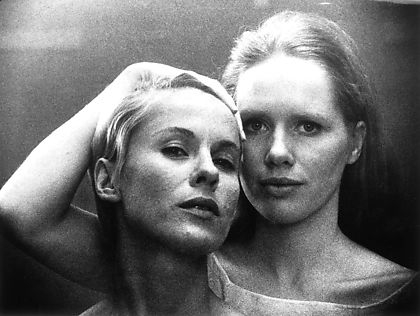
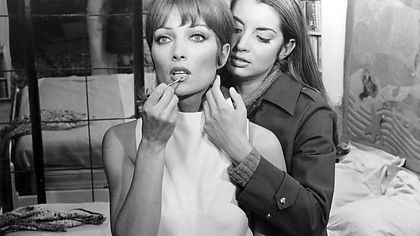
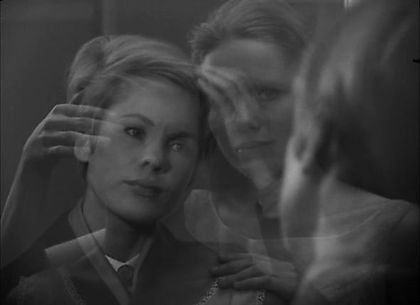
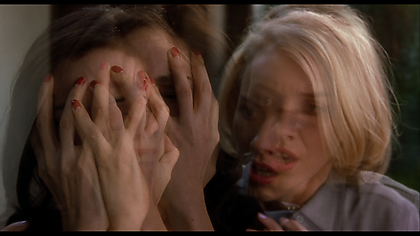
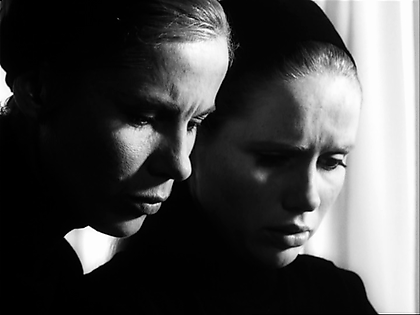
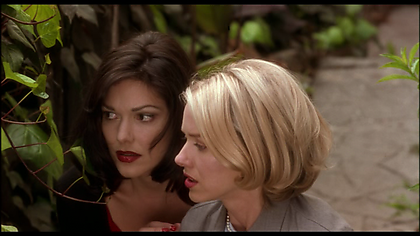
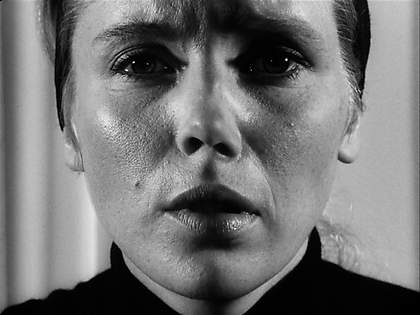
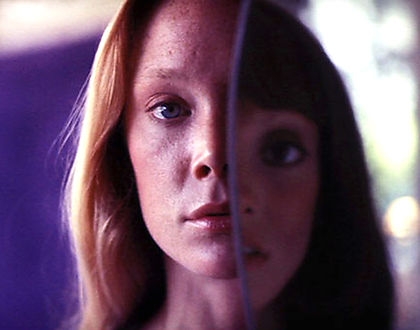
On Cinema
At the end of the sixties, Bergman increasingly resorted to self-reflexive devices, notably film-within-a-film at the beginning of Persona and Hour of the Wolf, or interviews with the actors on their character in The Passion of Anna. The most famous sequences probably remain Persona’s prologue and epilogue – where a boy, touching the split-screen image of a moving face, calls the viewers’ attention to the motion picture apparatus. This shot from Persona has been quoted by – among others – Jean-Luc Godard in his Histoire(s) du cinéma (1999), Philippe Garrel in Frontier of Dawn (2008) and Desplechin, towards the end of A Christmas Tale (2008), when Henri puts his hand on the hospital transparent curtain that separates him from his impassive mother.
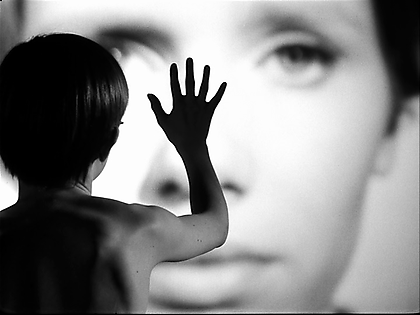
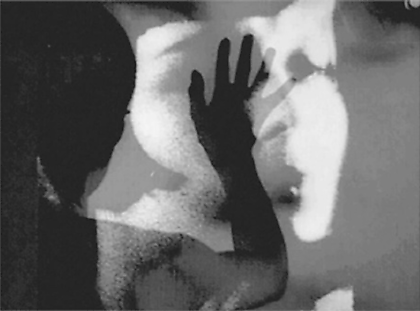
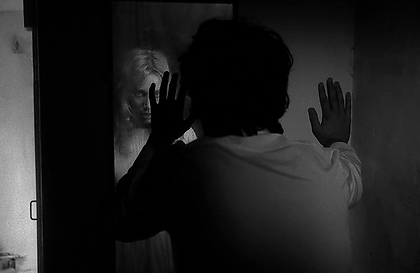
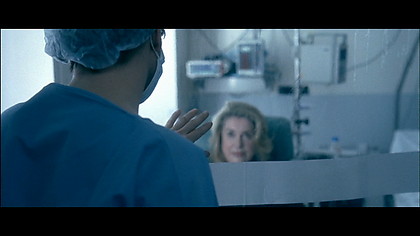
This famous shot may in turn have been taken by Bergman from Jean Cocteau's 1950 Orphée, described by Bergman in 1959 as “one of the most beautiful French films of all-time”.
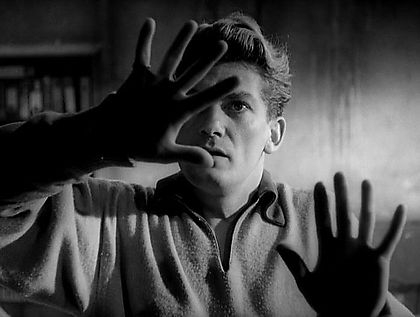
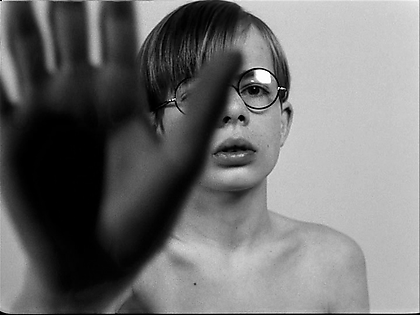
© Charlotte Renaud
[The "Legacy" section is written and compiled by Charlotte Renaud. Look here for heirs to other Bergman films.]
Distribution titles
Persona (USA)
Persona (France)
Persona (Spain)
Persona (West Germany)
Persona (Bulgaria)
Production details
Working title: Kinematografi
Production country: Sweden
Swedish distributor (35 mm): Svensk Filmindustri, Svenska Filminstitutet
Swedish distributor (35 mm): (video for rental and for sale) (physical): Svenska Filminstitutet
Laboratory: FilmTeknik AB
Production company: Svensk Filmindustri
Aspect ratio: 1,37:1
Colour system: Black and white
Sound system: Optical mono
Original length (minutes): 85
Censorship: 104.736
Date: 1966-08-31
Age limit: 15 years and over
Length: 2320 metres
Release date: 1966-10-18, Spegeln, Stockholm, Sweden, 85 minutes
Filming locations
Filmstaden Råsunda, Stockholm, Sweden.
Fårö, Sweden
Music
Title: Concert for the violin in E-major
Composer: Johann Sebastian Bach
Doctor: I understand, all right. The hopeless dream of being – not seeming, but being. At every waking moment, alert. The gulf between what you are with others and what you are alone. The vertigo and the constant hunger to be exposed, to be seen through, perhaps even wiped out. Every inflection and every gesture a lie, every smile a grimace. Suicide? No, too vulgar. But you can refuse to move, refuse to talk, so that you don't have to lie. You can shut yourself in. Then you needn't play any parts or make wrong gestures. Or so you thought. But reality is diabolical. Your hiding place isn't watertight. Life trickles in from the outside, and you're forced to react. No one asks if it is true or false, if you're genuine or just a sham. Such things matter only in the theatre, and hardly there either. I understand why you don't speak, why you don't move, why you've created a part for yourself out of apathy. I understand. I admire. You should go on with this part until it is played out, until it loses interest for you. Then you can leave it, just as you've left your other parts one by one.
Alma: To change oneself. My trouble is laziness.
Alma: Is it really important not to lie, to speak so that everything rings true? Can one live without lying and quibbling and making excuses? Isn't it better to be lazy and lax and deceitful? Perhaps you even improve by staying as you are.
Alma: I wonder whether your madness isn't the worst kind. You act healthy, act it so well that everyone believes you--everyone except me, because I know how rotten you are.
Mr Vogler: The important thing is the effort, not what we achieve.
Elisabet: Nothing.
Russell Merritt, 1996:
The temptation is to take Bergman's masterpiece for granted. It is probably the most famous of all those modern, post-Pirandellian films concerned with themselves as works of art. It also contains one of the most truly erotic sequences on film, demonstrating what can be done on screen with told material.
An actress named Elizabeth (Liv Ullmann) elects to become silent and is put into the care of Alma (Bibi Andersson), a nurse companion. The actress's act, we soon learn, has two aspects: it is a wish for ethical purity, but it is also a species of sadism, a virtually impregnable position of strength from which to manipulate her nurse, who is charged with the burden of talking. By the end of the film, the two characters are engaged in a desperate Strindberg-like duel of identities, and Bergman has turned that struggle into a metaphor for the fate of language, art, and consciousness itself.
Collaborators
- Ingmar Bergman, Director and screenplay
- Sven Nykvist, Director of Photography
- Ulla Ryghe, Film Editor
- Kerstin Berg, Script Supervisor
- Bibi Lindström, Art Director
- Max Goldstein, Costume Designer
- Börje Lundh, Make-up Supervisor
- Tina Johannsson, Make-up Supervisor
- Karl-Arne Bergman, Property Master
- Lars Johan Werle, Music Composer
- Johann Sebastian Bach, Music Composer
- Evald Andersson, Sound Effects
- Per-Olof Pettersson, Production Mixer
- Lars-Owe Carlberg, Production Manager
- Bo A. Vibenius, Unit Manager
- Lars Johnsson, First Assistant Cameraman
- Anders Bodin, Camera Operator
- Lennart Engholm, Boom Operator
- Lenn Hjortzberg , Assistant Director
- Olle Jakobsson, Re-recording Mixer
- Bibi Andersson, Nurse Alma
- Liv Ullmann, Elisabet Vogler
- Margaretha Krook, The doctor
- Gunnar Björnstrand, Mr. Vogler
- Jörgen Lindström, The boy, Elisabeth's son
- Mago
